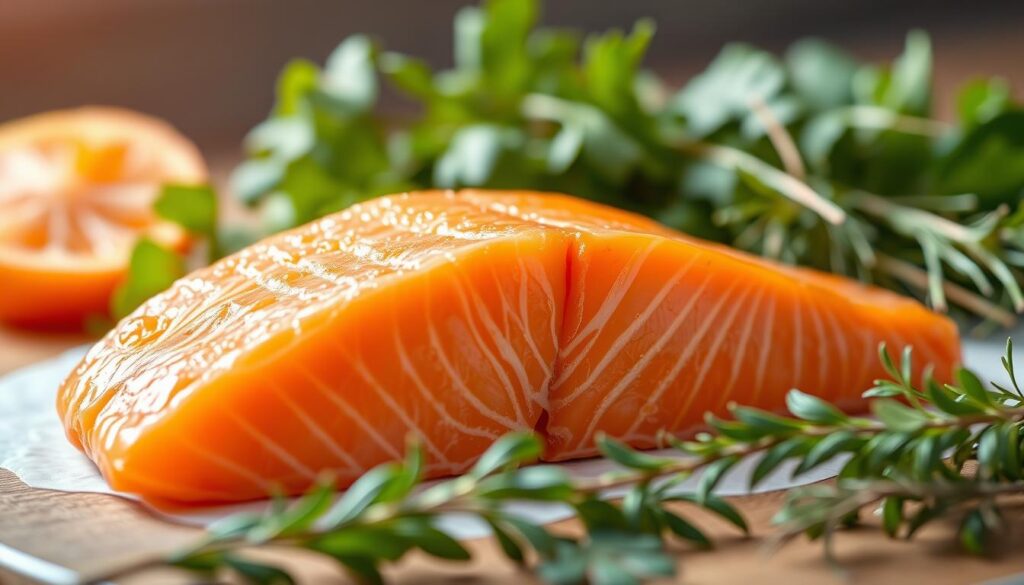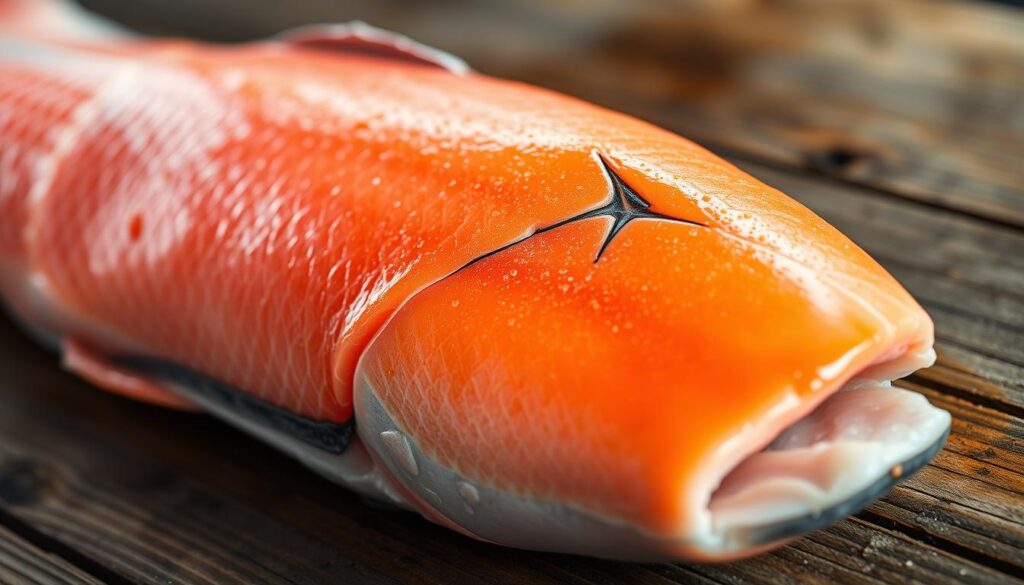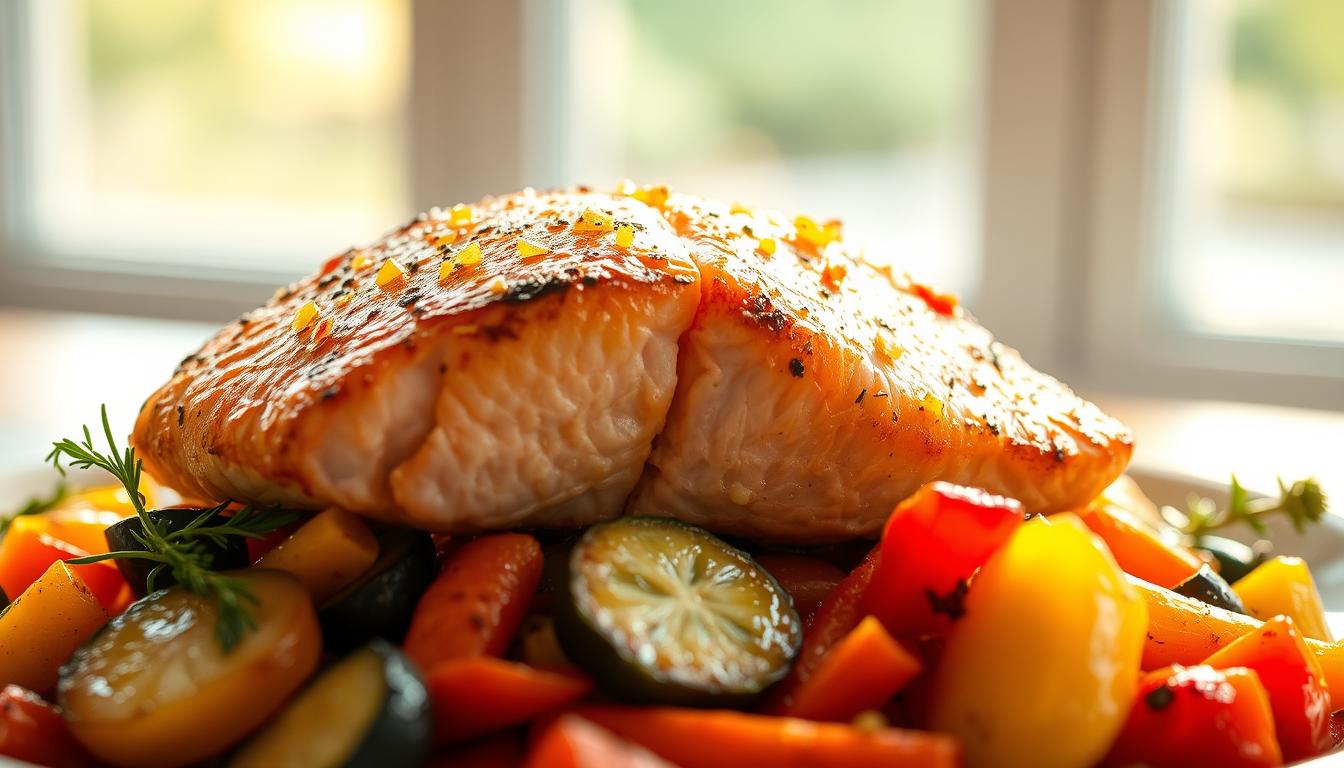Delicious Salmon Meal Ideas for a Nutritious Dinner
Delicious Salmon Meal Ideas for a Nutritious Dinner
Imagine a dinner that’s both healthy and quick. Salmon fits the bill perfectly. It’s full of omega-3s and cooks fast, making it ideal for busy nights. You can grill, bake, or add it to a grain bowl for a simple yet satisfying meal.
Timing is key. Cook it for 5–6 minutes on each side for tender flakes. With recipes under 20 minutes, you can enjoy a delicious salmon meal without much effort.
Imagine a weeknight where dinner is a breeze. Salmon grain bowls are ready in 15 minutes. Sheet-pan dinners clean up fast, and Mediterranean plates are full of veggies. These meals are quick and healthy, offering 25g of protein and 8g of fiber in each serving.
Marinades in under two hours add bold flavors without long prep times. These meals balance taste with nutrients like potassium and vitamin C.
Table of Contents
Key Takeaways
- Cook salmon to perfection in under 20 minutes, avoiding overcooking for moist texture.
- Each serving delivers 25g protein, 8g fiber, and heart-healthy fats like omega-3s.
- Sheet-pan methods cut cleanup time, while wild rice blends add whole grains to meals.
- Tahini sauce and dark leafy greens boost nutrition, supporting brain and heart health.
- Popular options like poke bowls and Mediterranean plates make salmon a versatile protein choice.
The Health Benefits of Including Salmon Meals in Your Diet

Eating salmon regularly can offer powerful benefits of salmon that support long-term well-being. These fish provide a nutrient-rich package of omega-3s, protein, and vitamins. They are a smart choice for heart, muscle, and bone health.
Omega-3 Fatty Acids and Heart Health
- A 3-ounce salmon portion delivers 1.5–2 grams of omega-3s, meeting daily recommendations in one meal.
- Omega-3s reduce inflammation, lower blood pressure, and boost HDL (“good”) cholesterol while reducing LDL (“bad”) cholesterol.
- The American Heart Association advises eating salmon twice weekly to reduce heart disease risk.
Protein Content and Muscle Development
- Each 3-ounce serving offers 22 grams of protein—critical for muscle repair and growth.
- Research shows salmon protein enhances muscle synthesis better than isolated amino acids.
- Wild-caught salmon’s lean protein makes it ideal for active lifestyles or aging adults maintaining muscle mass.
Vitamin D and Bone Health
- Sockeye salmon provides 71% of your daily vitamin D needs in one serving, aiding calcium absorption for strong bones.
- Vitamin D in salmon helps prevent osteoporosis and supports immune function.
- Wild salmon also contains astaxanthin, an antioxidant linked to heart and brain protection.
Wild-caught salmon also offers environmental benefits, requiring fewer resources than land-based proteins. With its nutrient profile, salmon becomes a versatile option for boosting health without sacrificing flavor.
Understanding Different Types of Salmon for Your Meals
Salmon is a favorite in the U.S., after shrimp. Knowing the differences between types is key. Wild-caught salmon, like Pacific species, has its own perks. But, your choice depends on what you value most.

Atlantic vs. Pacific Salmon Varieties
Atlantic salmon is mostly farmed, raised in pens. Pacific salmon, like king (Chinook), sockeye, and coho, is wild-caught. Each has its own taste and texture:
- Atlantic: Mild flavor, soft texture, higher fat (11g/serving)
- Pacific wild: Firm, rich flavor, natural oils (7g/serving)
Wild-Caught Salmon: Why It’s Often the Superior Choice
Wild-caught salmon eats krill and plankton naturally. This gives it a vibrant color and more omega-3s. It also avoids artificial dyes and antibiotics found in farmed fish.
For example, sockeye has 1,500mg omega-3 per serving. But, a 2020 study found some wild salmon has trace PCBs. Yet, levels are still below FDA limits.
“All U.S. wild-caught salmon (except Puget Sound Chinook) is a sustainable choice,” says the Monterey Bay Aquarium.
Farm-Raised Salmon: What You Should Know
Farmed salmon is common in supermarkets. But, it has its downsides. It often gets antibiotics and artificial pigments to look like wild salmon.
Look for certifications like GlobalGap or BAP (Best Aquaculture Practices) for cleaner options.
When buying canned salmon, choose BPA-free cans of wild-caught for safety and flavor.
Essential Salmon Nutrition Facts You Should Know
A 3-ounce serving of salmon has 22 grams of protein, 121 calories, and 5.4 grams of fat. It includes 1.5 grams of omega-3 fatty acids (EPA/DHA). Salmon is packed with nutrients.
Wild King Salmon is especially good. It has 570 IU of vitamin D, over 70% of what you need daily. It also has 200% of vitamin B12 in just 3.5 ounces.
- Key Nutrients: 400 mg potassium, 43 mcg selenium, and less than 1 gram of saturated fat per 3 ounces.
- Omega-3s Matter: These fats help lower inflammation, support brain health, and reduce stroke risk. Wild King Salmon has double the omega-3s of farmed Atlantic varieties.
- Minimal Contaminants: Wild salmon has fewer pollutants than farmed options, making it safer for regular consumption.
Serving sizes are important. A 3-ounce portion of wild-caught salmon gives you all essential amino acids without carbs or sugars. Wild King Salmon has 1.5–2.0g omega-3s per serving, while farmed has 0.5–1.0g.
Salmon has low mercury, making it safer than tuna or swordfish for frequent eating.
Cook salmon to 145°F to keep its nutrients. Choose wild-caught for more vitamin D and selenium. Salmon is a sustainable protein choice—opt for MSC-certified wild salmon to support eco-friendly practices.
With 25 grams of protein per fillet, salmon fuels muscles. It also aids heart health, as recommended by the American Heart Association.
Quick and Easy Salmon Meal Prep Techniques
Make your cooking easier with these simple steps for easy salmon dinner ideas. Whether you’re busy or trying new recipes, proper prep keeps flavors and safety intact.
Proper Thawing Methods
- Thaw frozen salmon overnight in the fridge for safe defrosting.
- For faster results, seal fillets in a bag and submerge in cold water, changing water every 30 minutes.
- Microwave on 30% power in a microwave-safe dish, pausing halfway to avoid overcooking.
Skining and Deboning Tips
Remove skin by holding the tail end and sliding a knife between flesh and skin. Use tweezers to pluck out pin bones—look for tiny bones along the fillet’s spine. Save skin for broth or discard neatly.
Portioning Salmon for Different Recipes
Cut fillets into cubes for skewers or stir-fries, or slice thinly for quick pan-searing. For baked dinners, divide into 4-ounce portions to ensure even cooking. Batch-cook portions to use in salads, bowls, or wraps throughout the week.
Pair prepped salmon with roasted veggies like asparagus or sweet potatoes for hearty easy salmon dinner ideas. Store cooked meals in airtight containers for 3–4 days. Reheat in the microwave for a 1.5-minute nutrient-packed meal.
Perfect Salmon Meal Ideas for Weeknight Dinners
Cooking a healthy dinner doesn’t take all day. These healthy salmon recipes are quick and easy. Whether you’re cooking for a family or just for yourself, there are many options. Try baking salmon with a lemon-herb rub and roasted veggies in just 20 minutes.
Quick-Fire Options: Honey-garlic glazed salmon is a great choice. Marinate the fillets in soy sauce, honey, and garlic for 10 minutes before baking. Serve with quinoa or roasted asparagus. This dish has 253 calories and 26g protein, making it very satisfying. The USDA says to cook salmon to 145°F for safety.
One-Pan Magic: Cooking salmon with veggies saves time. Toss Brussels sprouts and sweet potatoes with olive oil, then roast with salmon fillets for 15 minutes. The veggies get all the fish’s juices, making a simple meal. Add a quick arugula salad for extra greens.
Prep Ahead Strategies: Cook salmon on Sunday to use all week. Store cooked fillets in airtight containers for up to four days. Use leftovers in grain bowls or on salads. For frozen meals, portion salmon with marinades in freezer-safe bags.
- Bake salmon with green beans and lemon wedges for a 20-minute dinner
- Combine salmon with farro and roasted carrots for a fiber-packed meal
- Use leftover salmon in creamy avocado wraps with rice paper
Adjust cooking times based on fillet thickness—thicker cuts may need 12-15 minutes at 400°F. Always check internal temperature with a thermometer. Leftovers are great for busy days. These recipes show that healthy meals can be simple.
Delicious Salmon Marinade and Seasoning Combinations
Turn salmon into a dish to remember by trying different flavors. You can go for tangy, smoky, or sweet. The right marinade makes every bite special.
- Teriyaki Marinade: Mix soy sauce, ginger paste, light brown sugar, sesame oil, rice vinegar, and black pepper. Let it marinate for 2-12 hours. Then, bake at 375°F for 15-20 minutes. This creates a delicious crust.
- Greek-Style Marinade: Whisk together olive oil, fresh dill, lemon juice, garlic, thyme, oregano, Dijon mustard, salt, and pepper. Brush it on salmon before grilling for 4-5 minutes per side.
- Maple-Mustard Glaze: Combine maple syrup, Dijon mustard, Worcestershire sauce, and minced garlic. Coat the salmon and bake until it’s flaky. Then, broil for 3-5 minutes to glaze it.
For those who like it spicy, try a chipotle marinade with adobo paste, chili powder, and garlic. Add a harissa blend with honey and herbs for a sweet-spicy mix. Adjust the garlic or citrus to your liking.
There are different ways to cook: bake at 375°F, grill 4-6 minutes per side, or air fry at 400°F for 10-12 minutes. Always check if it’s done with a fork—it should flake easily. Store leftovers in an airtight container for 2 days.
Marinate for at least 30 minutes (overnight is best) to soak up flavors. Use 1/4 cup olive oil as a base for most marinades. Adjust the lemon or vinegar to balance the saltiness.
Each 6 oz serving of these dishes has 395 calories, 26.5g protein, and less than 1g carbs. Top with fresh herbs like parsley or cilantro for a burst of freshness.
Sustainable Salmon Harvesting: Making Environmentally Conscious Choices
Sustainable salmon harvesting lets future generations enjoy this healthy fish. It also protects our ecosystems. Start by learning how fishing methods affect the environment. Choose options that cause less harm.
Wild salmon numbers have fallen to 25% of what they were in 1970. Opt for line-caught or small-scale fisheries to reduce bycatch and habitat damage. Avoid open-net pens that spread disease or waste. Look for:
- Marine Stewardship Council (MSC) certified wild-caught salmon.
- Aquaculture Stewardship Council (ASC) or Best Aquaculture Practices (BAP) labels for farmed options.
Check the Seafood Watch guide from the Monterey Bay Aquarium for top-rated choices. Over 39 salmon varieties are rated “Best Choice” or “Good Alternative.”
Choosing local salmon reduces transport emissions. Avoid imported options unless they’re certified. Farmed salmon with low feed ratios (1.1:1 to 1.5:1) use resources efficiently. Avoid brands with high mortality rates—some farms lose 25% of fish before harvest.
Small changes matter: choosing certified salmon supports fisheries that limit pollution and antibiotics. Even 15-minute meal prep can align with eco-friendly practices. Every choice helps protect wild stocks and marine life.
Pairing Suggestions to Complete Your Salmon Meal
Make every bite of your delicious salmon meals better with the right pairings. Acidic things like citrus or tangy sauces help balance the richness of salmon. Fresh herbs or crisp veggies add a nice brightness.
“Serve the salmon with avocado and rice, on a bed of salad greens, or simply as I did! The combination of coconut milk and spices works perfectly together, creating a rich yet light sauce that feels and tastes more complex than it actually is.”
Choose the right salmon for your dish. King Salmon is great with lemon-dill sauces or balsamic-glazed veggies. Coho goes well with creamy avocado salsa. For Sockeye, mango salsa’s sweet-spicy kick is perfect. Here’s how to match dishes:
- Asian-inspired: Coconut rice, bok choy, or miso-glazed eggplant
- Mediterranean: Lemony orzo, roasted veggies with tahini, or herb-infused couscous
- Wine pairings: Light whites like Pinot Grigio or crisp Sauvignon Blanc; for bold flavors, try a buttery Chardonnay
Build balanced plates with these tips. 38% of recipes include green veggies like asparagus. 21% have grains like quinoa. Half use citrus or herbs for freshness. Most sides are quick to make, with 66% easy for beginners. Try mustard-honey glaze for Chum Salmon or herb butter with Sockeye.
Play with textures to make your meal memorable. Crispy roasted potatoes contrast with flaky salmon. Creamy polenta softens spicy glazes. Try these combinations to make your delicious salmon meals unforgettable.
Conclusion: Incorporating Salmon Meals into Your Regular Meal Rotation
Salmon meals are a great way to improve your health and enjoy tasty dinners. They are full of omega-3s, which are good for your heart and brain. Plus, they have protein, which helps your muscles recover.
Begin by adding one salmon meal to your weekly plan. Then, you can increase it to two or three times a week, as health experts suggest.
Salmon is easy to cook. You can pan-fry it in just 10 minutes or bake it at 145°F. Serve it with roasted veggies or quinoa for a balanced meal.
For quick meals, prepare marinades in advance or freeze salmon. Ora King Salmon stays fresh even when frozen.
Looking to save money? Watch for sales or buy in bulk. Ora King Salmon is worth it because of its high omega-3s and vitamins.
Try different recipes to keep your meals interesting. Grilling, baking, or making one-pan dishes can add variety.
Health groups like the American Heart Association say salmon can lower heart risks. Choose wild-caught or sustainable options to help the environment.
Make salmon a regular part of your diet. Each meal brings health benefits and delicious flavors. Focus on quality ingredients and smart preparation. Your body and taste buds will appreciate it.

